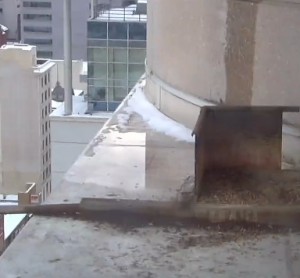Falcon Cam launched for 2014 mating, nesting season
 HARRISBURG – On Friday, Feb. 14, the Department of Environmental Protection (DEP) launched its annual live, 24-hour-a-day webcast of a nesting pair of peregrine falcons who live on a ledge of the Rachel Carson State Office Building in Harrisburg.
HARRISBURG – On Friday, Feb. 14, the Department of Environmental Protection (DEP) launched its annual live, 24-hour-a-day webcast of a nesting pair of peregrine falcons who live on a ledge of the Rachel Carson State Office Building in Harrisburg.
Three high-definition (HD) cameras will chronicle the falcons’ activities – they typically renew their pair-bond around Valentine’s Day – while streaming the footage live on the internet to viewers around the world. Around the time the first egg is laid, an additional HD camera will be set up for an intimate view into the nest, a DEP news release said.
“Year after year, the Falcon Cam is one of the most popular features on our website,” DEP Secretary Chris Abruzzo said. “It’s a great tool to get Pennsylvanians engaged in the environment.”
In recent weeks, a male peregrine has challenged the resident male, who has been at the ledge since 2005. Despite that, the resident male has defended the ledge, and will soon begin to mate with the female, who has been at the ledge since 2012. Breeding activity typically takes place this time of year, so territorial battles can be fierce, the release said.
In the 14 years that falcons have been nesting at the building, the nest has produced 52 eggs and 44 hatchlings. Of these, 34 falcons survived — 14 males and 19 females. The gender of one of the nestlings that hatched in 2008 could not be determined. That bird was the runt of the clutch, or set of offspring, the release said.
Last year, the female falcon laid a clutch of four eggs, and all four hatched. The first egg of the 2014 breeding season should be laid around mid-March. The eggs should begin to hatch around mid-April, and the young falcons, also called eyases, will begin to take their first flights, or fledge, in early-June, according to the release.
While their numbers are increasing, the Pennsylvania Game Commission still lists peregrine falcons as an endangered species at the state level. Nationally, the U.S. Fish and Wildlife Service removed the bird from its list of endangered and threatened species in 1999, the release said.
The birds’ population in Pennsylvania has increased since the early 1990s as a direct result of conservation efforts like this one. According to the Game Commission, 40 pairs of peregrine falcons are nesting at various locations across the state, the release said.
For more information, to sign up to receive the Falcon Wire e-newsletter, or to watch the falcons live, visit http://www.dep.state.pa.us/dep/falcon/default.htm.





